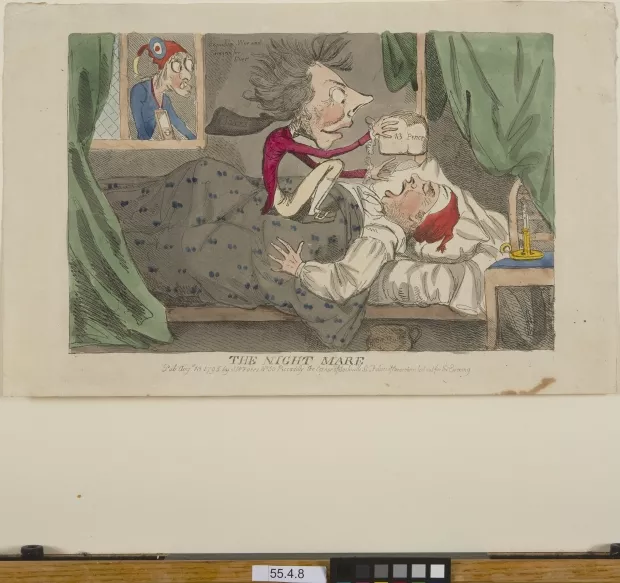Creation Date
1795
Height
25 cm
Width
36 cm
Medium
Genre
Description
This political caricature satirizes Fuseli's The Nightmare, utilizing the latter's Gothic theme to combine a fear of the unknown with a critique of government exploitation.John Bull (indicated by the name on the chamber pot under his bed) sleeps under a grey blanket, surrounded by green curtains. His mouth is open as he snores. On his chest sits an impish official, William Pitt, with wild hair and a red coat. He is labeled “Taxes” and holds a loaf of bread bearing the words “13 Pence” over Bull’s head. A man, with very large eyes and wearing a red hat with the tricolored rosette of the French Revolutionaries, watches through the window in the upper left corner. Written on the wall by the window is “Republic War and Famine for Ever.” This political caricature satirizes Fuseli's The Nightmare, utilizing the latter's Gothic theme to combine a fear of the unknown with a critique of government exploitation.
While the image pokes fun at the event of the bread shortage, it also points to the underlying terror of famine (George, entry 8671). The comedic Night Mare ultimately conveys more than humor by parodying Fuseli’s The Nightmare, a sinister and disturbingly erotic painting. In the caricature, Fuseli’s demon is replaced by a government official stealing bread from the English people (represented by John Bull, the substitute for the sleeping maiden in the painting). A bug-eyed Frenchman stands in for Fuseli’s devilish horse. The intent of the image is to satirize the government’s reaction to the bread shortage and to point out the shortage's connection to the French Revolution. The reaction to the work is, consequently, a strong one: the horror of the unknown underlies and emphasizes the panic of famine. By drawing an analogy between these fears, the caricaturist has created an image powerful in its allusion to the paralyzing uncertainty and disorder of chaos.
Associated Persons
Associated Works
Locations Description
A wheat shortage in Europe led to bloody bread riots in 1795 among the peasants of France. England was not secure from the famine, and at least fifty-eight different riots broke out between March and November (Webb 5). Bread features prominently in this image, which was created in 1795.
Copyright
Copyright 2009, Chazen Museum of Art, University of Wisconsin-Madison
Collection
Accession Number
Copyright 2009, Chazen Museum of Art, University of Wisconsin-Madison
Additional Information
Bibliography
"Fuseli: The Nightmare." Mark Harden's Artchive. n.p., n.d. Web. 28 Mar. 2009.
George, M. D. Catalogue of Political and Personal Satires. Vol. VII. London: Published by order of the Trustees, 1942. Print.
Webb, Samantha. "Not so Pleasant to the Taste: Coleridge in Bristol during the Mixed Bread Campaign of 1795." Romanticism 12.1 (2006): 5-14. Project Muse. Web. 28 Mar. 2009.

